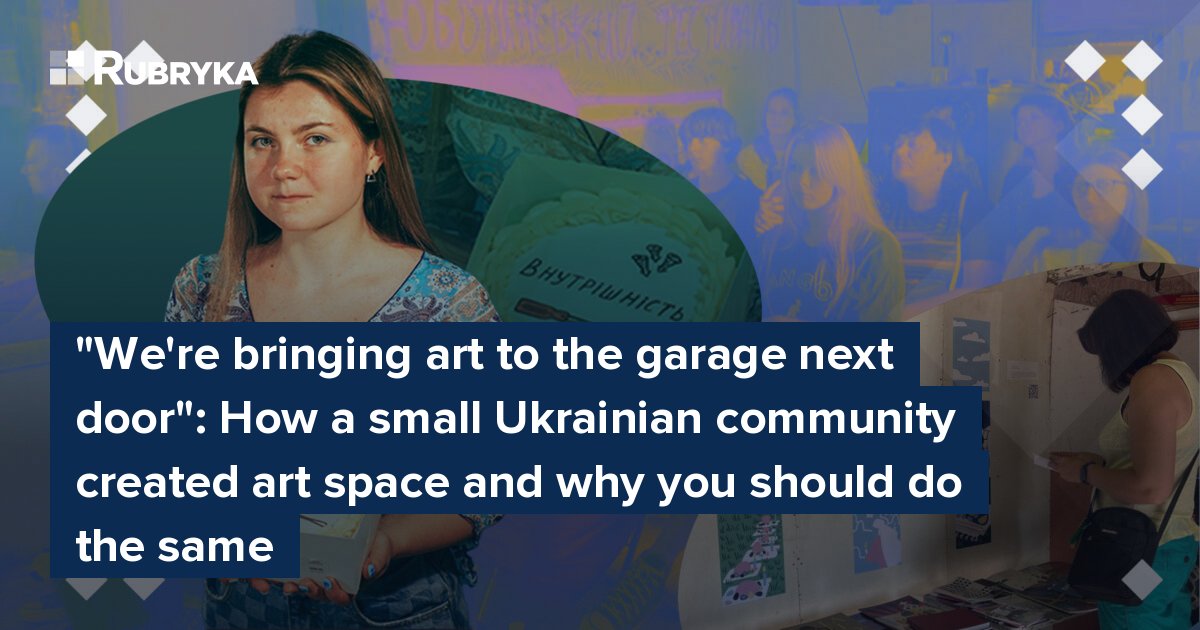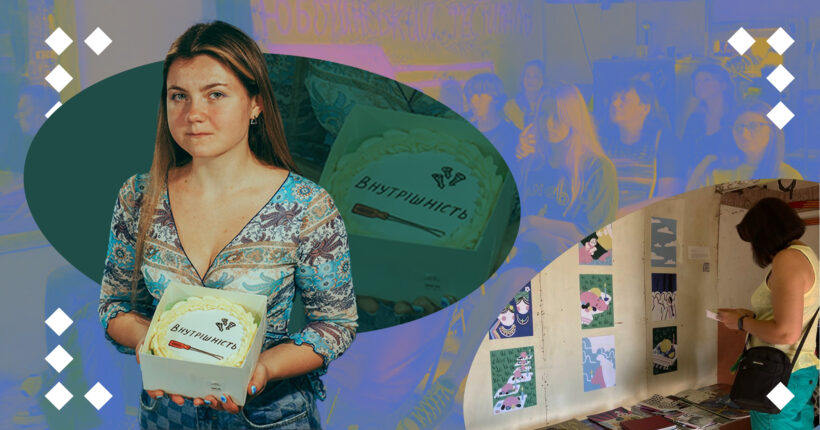
What's the problem?
Ukraine's most prominent cultural events usually occur in big cities like Kyiv. Residents of these cities are exposed to diverse art — from classic painting exhibitions to visual contemporary art in prominent centers like Mystetskyi Arsenal National Art and Culture Museum Complex or Pinchuk Art Center in the Ukrainian capital. They get to experience more, which often leaves small-town residents out of the cultural loop.
This trend limits opportunities for local talents, and since Russia started its full-scale war against Ukraine in 2022, the problem worsened. Since the war, culture has been underfunded because money is directed to defense, and spaces in large cities, which are often targets of Russian air strikes, are inaccessible due to the dangers of wartime.
What's the solution?
A journalist from the Kharkiv region, Kateryna Deviatko, decided to bring art to the outskirts and make it more accessible for people in smaller communities. In the town of Lyubotyn, she turned an ordinary garage into a temporary art space, with the main idea of decentralizing art — spreading its presence beyond major cultural hubs in big cities.
We spoke to the founder of the Vnutrishnist art space to learn how it works and what it takes to create more places like this.
How does it work?
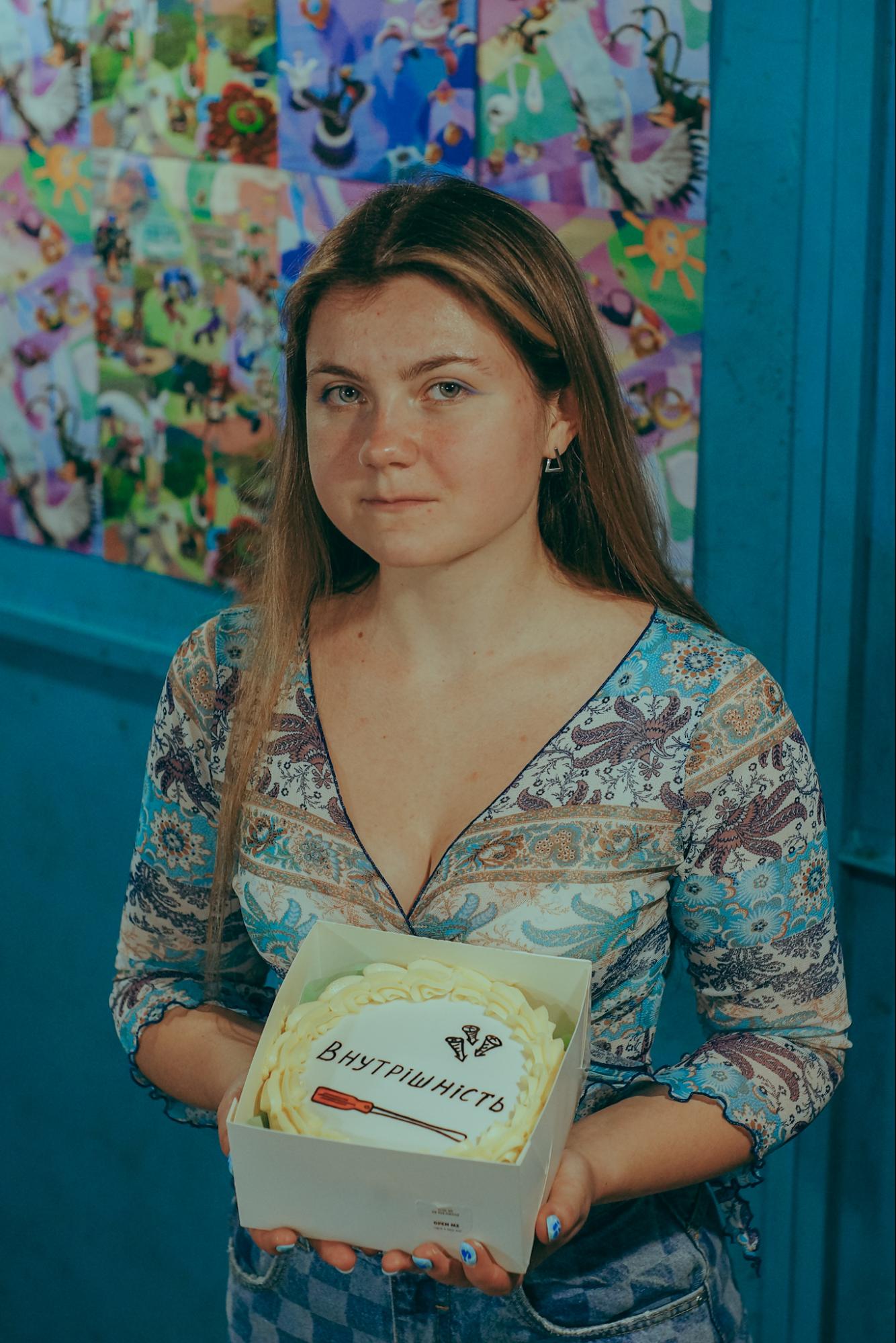
Kateryna Deviatko, art space founder, with a cake her mother baked for the space's opening. Photo by Sasha Odnolitkova
Kateryna Deviatko, the founder of the temporary art space "Vnutrishnist," is 21. She's a journalist and communications manager at the Ukrainian nonprofit organization Wanted Here. Katia became interested in art spaces and art in general after visiting the Biennale of Young Art in the regional capital, Kharkiv, in 2019. At the time, she was a first-year student who had just moved from Liubotyn to Kharkiv.
"I was captivated by the atmosphere of the space, which felt detached from reality," says Kateryna — Katia for short. "I loved deciphering the meanings behind the artworks and carrying those thoughts into my daily life. I must have visited the main venue at the 'Kharkiv' hotel about ten times, maybe more." The hotel often hosted art exhibitions.
Kateryna's interest grew into a personal exploration. She started digging deeper and putting together her impressions into something unique. However, the full-scale war disrupted her plans — she had to evacuate from the heavily bombarded Kharkiv to safer western regions of Ukraine. Eventually returning to her hometown this spring, Kateryna rented an apartment in her hometown, which came with a bonus: a garage.
"When I first walked in there, I immediately knew—the stars had finally aligned, and this would be the space"
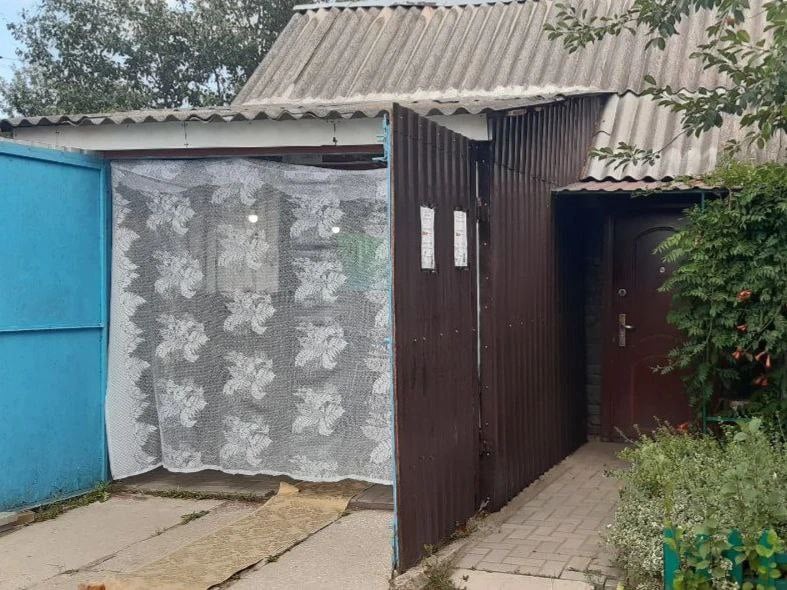
This garage became a location for the Vnutrishnist Art Space. Photo: Lidia Starodubtseva
By creating a local art space in a region close to the front lines, Kateryna Deviatko wanted to respond to the horrors of war with a life-affirming project. Her idea was for "Vnutrishnist" to bring people together for self-reflection and cultural enrichment, hoping that this could help them further distance themselves from Russia mentally and culturally and reaffirm Ukrainian identity.
"This is especially important now, as we root out everything artificially Russian from our lives, leaving space that must be filled with something truly Ukrainian," says the art space founder. "This is something valuable I can do for my city right now."
Liubotyn is 30 kilometers from Kharkiv, the front-line city attacked by Russian forces daily. Kateryna believes that opening a project like hers in her town and "to show up here, where a missile can reach you in less than a minute, is like looking Russia in the eye and saying, 'Stick it!' and laughing loudly."
The only thing left was to explain the idea to the garage owner. That turned out to be easy — the landlady simply said, "Katia, you're creative! If you need to, go ahead."
Five volunteers joined the project team, whom Kateryna calls "Vnutrishni," meaning "Insiders." This nickname was inspired by the project's name, "Vnutrishnist," which can be loosely translated from Ukrainian as "interiority." "Insiders" are Kateryna's friends from Liubotyn and beyond, as well as people she met while working on the project.
Thinking outside the box

The art space in the garage — hay on the ceiling, wallpaper on the floor, and a film festival on the walls. On the right is Kateryna Deviatko. Photo from the project archive
Before she had a team, Kateryna did everything by herself. After work, she would change clothes and head to the garage to clear out the junk, sweep, and scrub it clean. She says it used to be just an ordinary garage with typical "guy stuff." It was never cleaned, so after each cleaning round, she would come home, and the water from her shower would be pitch black.
"I lived for a month without furniture in my kitchen — no table or chairs — because I took them to the garage where I needed them more," says Kateryna, laughing. "It was unusual, but it also helped me step out of my comfort zone and try something new. For example, food tastes more flavorful."
No hammer to drive in nails? No problem for Kateryna! There was always a "convenient rock" in the garage, which worked just as well as a hammer. With ingenious solutions as such, it took two weeks to get the garage in order.
When Katia and her friends started, the neighbors looked at them with eyes wide open because there was always a cloud of dust around the garage, and the "workers" constantly carrying things in and out looked "dirty as devils." The neighbors would only ask why they were doing all this, and Katia would answer bluntly, "We're creating an art space." The idea was accepted because no one ever interfered or complained. People also said that Katia had brought new life to the neighborhood.

Katia is showing an exhibit. Photo by Sasha Odnolitkova
The Vnutrishnist Art Space opened on June 1, with 30 people showing up all at once to the opening. The project's initiator says everyone was pleasantly shocked. It was unexpected and exciting. According to its founder, it was also meant to be temporary and will close on August 31.
"For now, this is just a one-summer story," says Kateryna. "Every summer is an opportunity to live a small life within a big life. It's a chance to be bolder, more open, and more alive than usual. Summer, this time of the year, is about understanding that everything is temporary because when you realize that, you value the moments that happen before it ends."
"Vnutrishnist is about the desire to make an effort, to look deeper and find what's not obvious"

Screenwriting workshop by Liubotyn filmmaker Diana Stryzhak. Photo from the project archive
According to the founder of "Vnutrishnist," the space is geared toward young people and those looking for meaningful ways to spend their time and opportunities for self-development. However, there's room for everyone — children, older adults, dogs that come with their owners, and many stray cats that usually hang around garages.
One of the first events held in the art space was an exhibition called "Nothing Is More Permanent Than the Temporary." The exhibition featured 20 works by artists from seven regions of Ukraine chosen from 70 applications submitted for the open call.
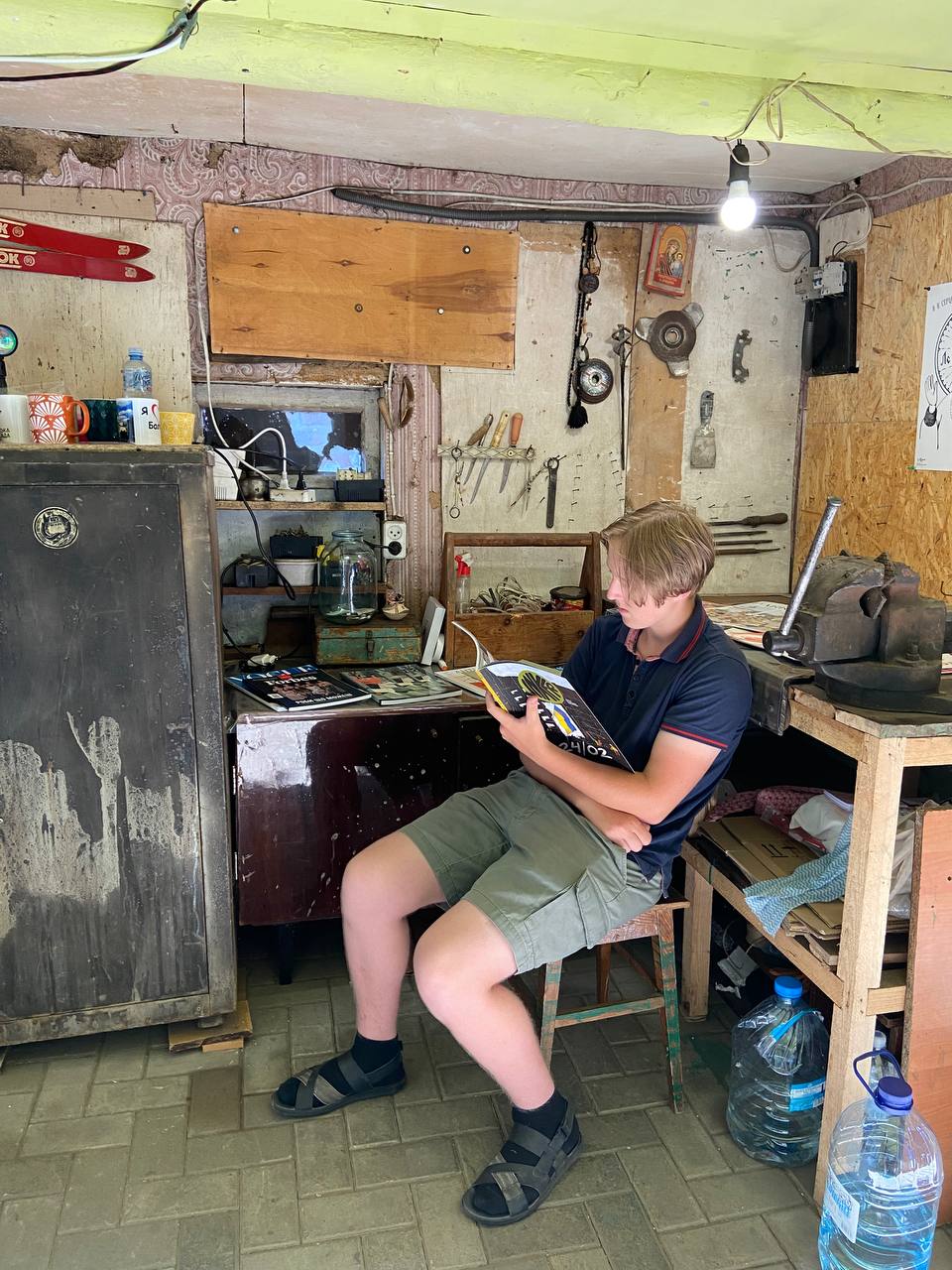
A young visitor is reading a zine — a photo brochure. Photo from the project archive
The former garage also hosted a music jam and zine weekends, where people could check out a collection of contemporary self-published zines — photo brochures — owned by Kateryna Deviatko, which includes over 30 different issues. Artists from Liubotyn and Kharkiv held several workshops on candle making, zine creation (DIY mini-magazines on any topic of interest), and more.
In August, "Vnutrishnist" hosted a significant event — the first-ever short film festival in Liubotyn. The festival aimed to give amateur filmmakers a platform to express themselves and showcase their work. For the people of Liubotyn, it was a chance to discover modern amateur cinema, attend workshops on the subject, interact with others, and experience a different kind of film than what is shown in regular theaters.
The festival theme was "the nighttime darkness that sways the curtains." As Katia explains, it represents the late summer night thoughts that come to you with the cool breath of darkness. "We wanted to portray these thoughts, and we succeeded," says the art space founder.
Artists from different regions of Ukraine participated in the event, which featured 16 films in four categories: short narrative film, short documentary film, short mockumentary film, and short animated film.
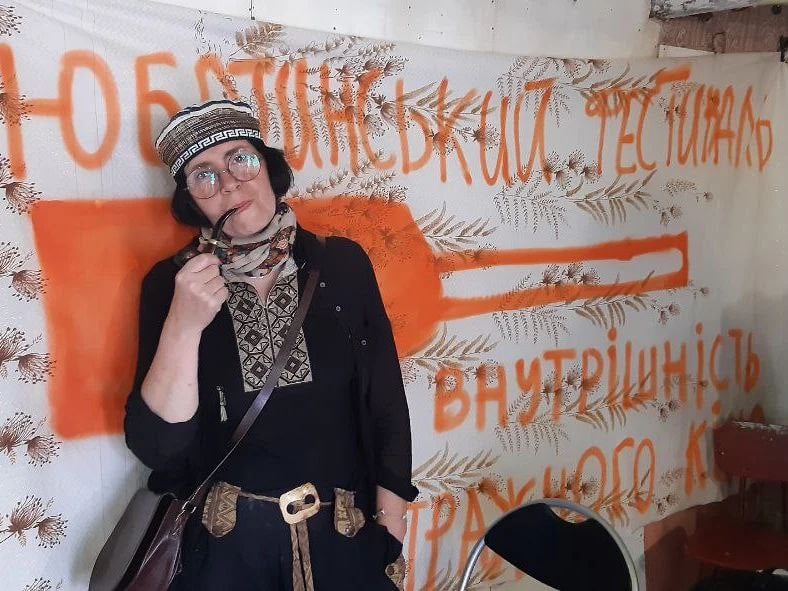
Filmmaker Lidia Starodubtseva at the film festival. Photo from the project archive
The judges and experts included animation director Svitlana Mahda, director and artist Hanna Trofimova, and filmmaker Lidia Starodubtseva, who is a professor and head of the media communications department at Karazin Kharkiv National University and the author of a series of documentary films and video art projects.
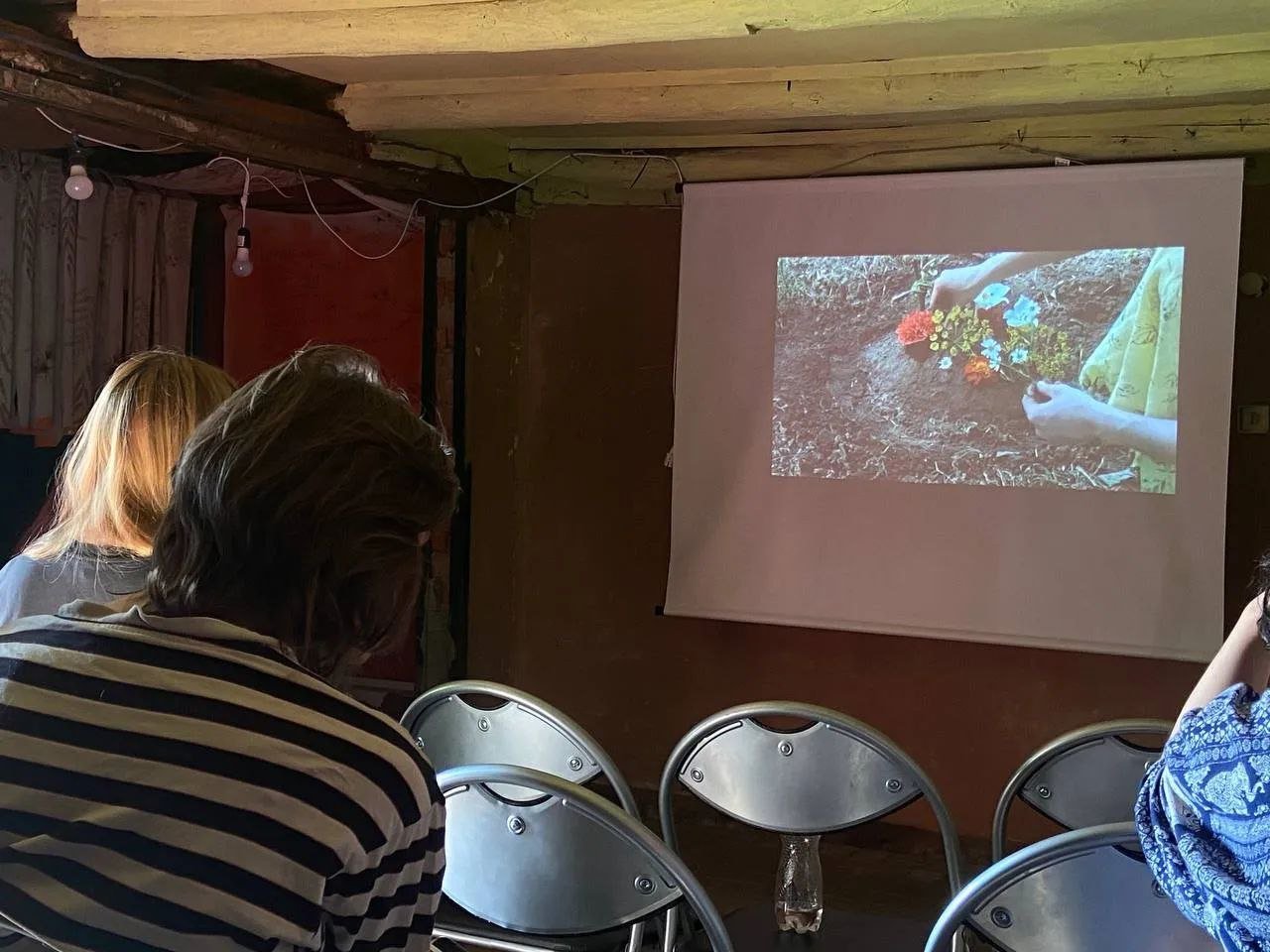
Visitors watch films at the festival. Photo from the project archive
"We received overwhelming support from the artists, offers for collaboration, shares of our announcements, and words of gratitude and admiration. Over the two days of the festival, it was attended by about 40 people. The hall was always full!" Kateryna Deviatko proudly says.
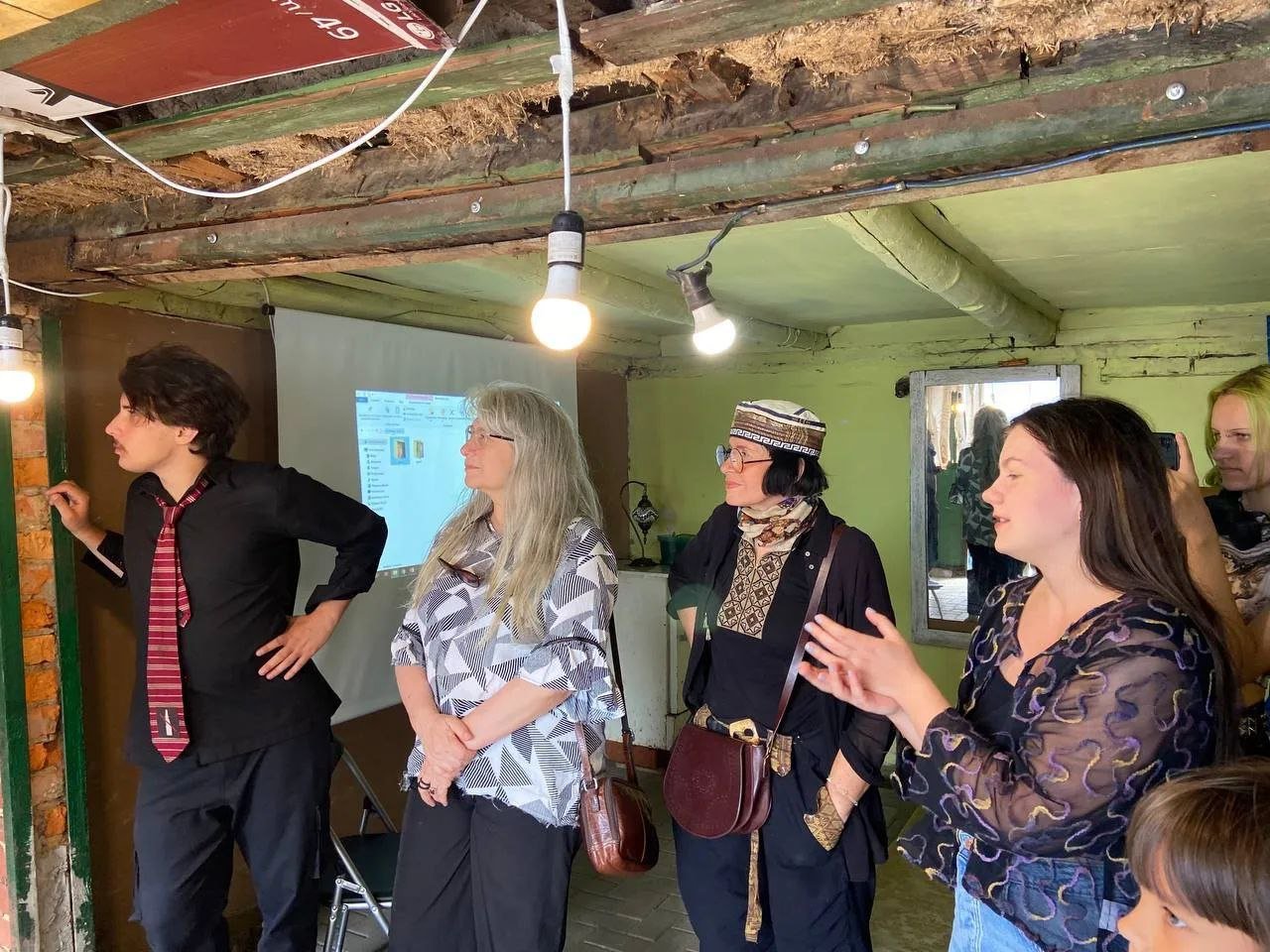
Guests at the festival. Photo from the project archive
The winners in each category received a prize — a set of curtains for a doorframe. The festival organizers also created an online catalog for viewing the films, so now anyone can watch the competing films.
Does this really work?

Exhibition "Nothing Is More Permanent Than the Temporary." On the wall are nature paintings by an artist with visual impairments. Photo from the project archive
In just two months, an empty garage on Svitla Street transformed into a place where people can find like-minded individuals and attend unique events. Many of the events are organized by people who live in Liubotyn.
"The main goal of 'Vnutrishnist' is the decentralization of art," says Kateryna Deviatko. "We're bringing art to a garage next door and showing that it's not out of reach but accessible to everyone. We demonstrate that there are amazing people nearby, people from Liubotyn who walk the same streets as everyone else."
The founder of the art space believes art is a language that can be used to think, talk, and solve problems, and "Vnutrishnist" shows visitors how to understand that language.
People enjoy being in the space. They form a regular audience that frequently visits "Vnutrishnist," where they interact a lot and which they make more lively. For example, in collaboration with the NGO Trubadury, "Vnutrishnist" is preparing for a special event called "A Day with the Sviatopolk-Mirskyi Estate," scheduled for August 25.

Candle-making. Photo from the project archive
"At first, we aimed for larger crowds, but I soon realized that our value and uniqueness lie in our ability to engage more deeply with fewer visitors. This way, we can offer them more quality time," says Kateryna. "I also noticed that people come specifically for certain events; they're not interested in just dropping by an exhibition like they might in Kharkiv. This is one of the big differences between Kharkiv and Liubotyn — the scale is different."
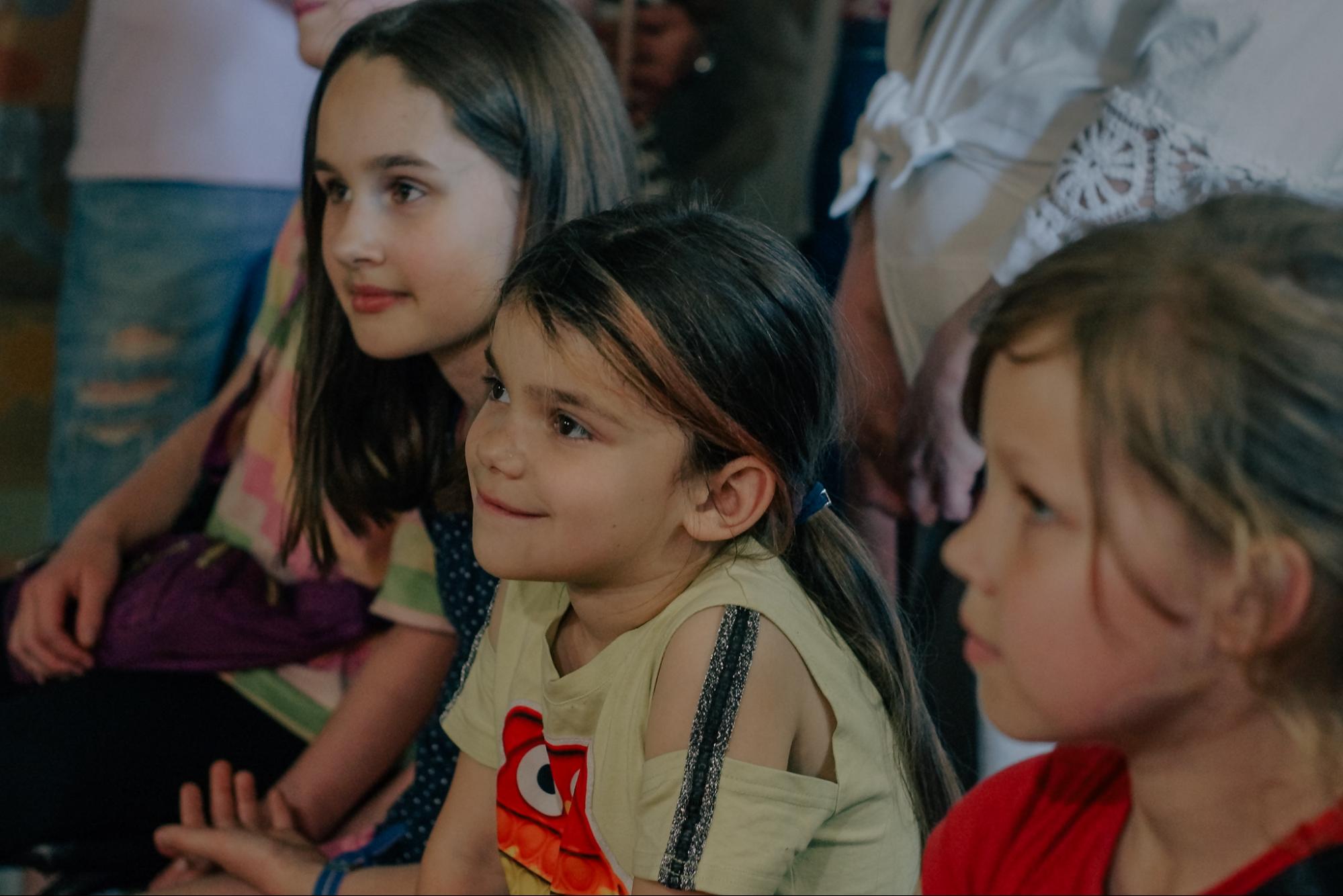
Children at Vnutrishnist Art Space. Photo by Sasha Odnolitkova
According to the founder, the project's whole story is about how a flat, empty space was transformed into a vibrant one that encourages dialogue, brings new meanings, and becomes a place people want to return to. It's no coincidence that the main symbol of the space is a screwdriver, which lies on a mirror. It's an invitation to unscrew the bolts that hold the outer layers in place and look into the mirror to see your inner self. To be inwardly focused, not outwardly, because only then will this space be meaningful for you.
Even more helpful solutions!

Exhibition of zines. Photo from the project archive
The experience of Kateryna Deviatko and her like-minded companions demonstrates that it is possible to create an event space that brings joy to people anywhere and anytime. The key is understanding why you want to do it and what you hope to achieve — in Kateryna's case, it was vital for her to express herself, bring people together, and create a platform for artists, even if only for one summer. Kateryna offers a few practical tips:
Trust yourself and analyze available resources.
- Imagine you have no budget constraints and can spend as much as you need. Honestly, visualize what attracts you to that imagined space. Fix that feeling in your mind or on paper.
- Simplify the imagined space, but make sure the feeling you identified remains intact. Which elements couldn't you eliminate? What are they, and why do they convey that feeling?
- Think about where you can find these elements locally and who you can ask. For instance, the needed item might lie unused in an attic, or a friend has the necessary skill.

Poster on the curtain that Katia's grandmother gave her.
Be honest. Feel free to communicate and negotiate.
When Katia's team was looking for artists for the project, they sent out open calls to all art communities on Telegram. Along with their more than 300 followers, they reposted the information, shared it in local groups and chats, sent invitations to co-op chats, and Kateryna even enlisted the help of her mother, a local opinion leader. They also hung their posters on laundry lines around Romashka, the neighborhood where "Vnutrishnist" is located. Later, the media and public pages picked up information about "Vnutrishnist," the space's announcements even made it into Google recommendations twice.
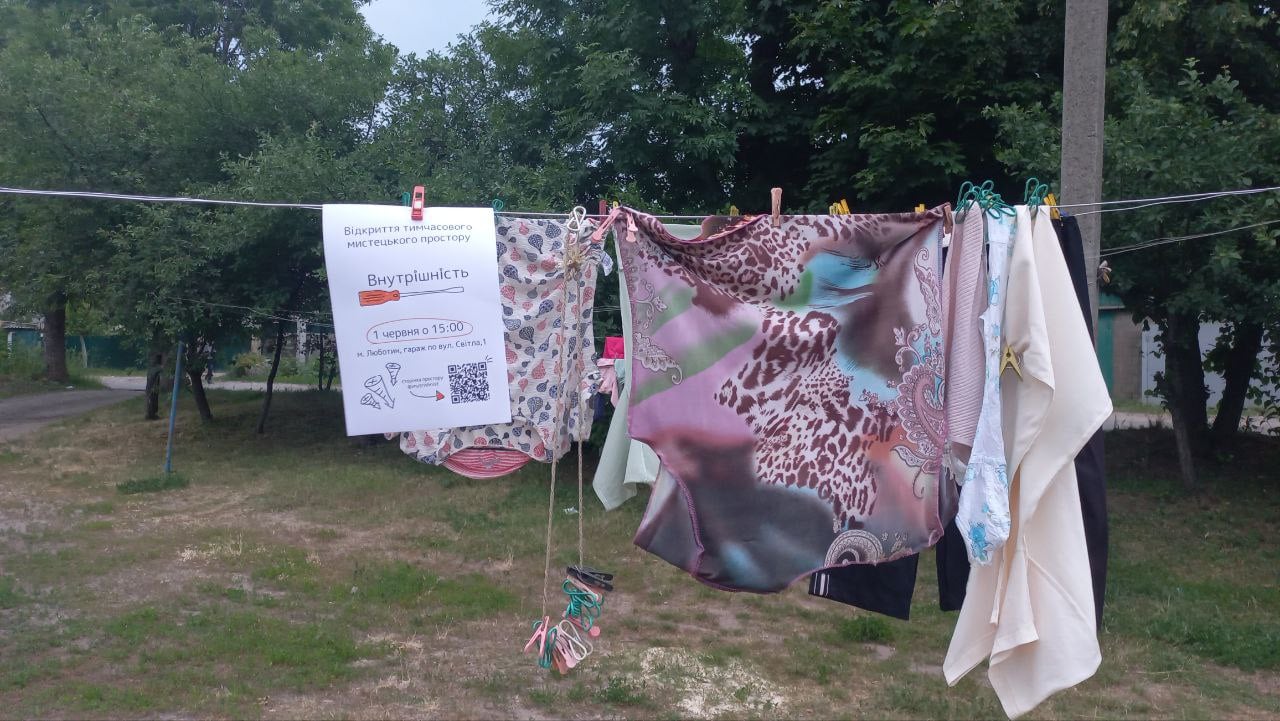
The advertising was distributed like this, too.
"I was always open and honest about my ideas, and when I needed help, I explained to people why it was important. This way, I involved great people I had worked with and new people I hadn't known before 'Vnutrishnist,'" Kateryna Deviatko comments.
Time management.
Allocate twice as much time as you think you'll need. Plan for two if you believe you can complete a task in a week. Unexpected issues will always require more time to resolve.
Delegating tasks.
Kateryna Deviatko assembled a large team, and each person was skilled in something specific. For example, Alina handles filming, photography, and editing; Katia, as an artist, knows how to advise on layout and placement; Sasha, even remotely, contributes fresh ideas and deep thoughts; Katia and Vova assist with hands-on tasks. Many friends can help upon request.
"It's okay to ask for help, even if you can do it yourself," the founder of the space asserts. "It's important to communicate what's needed, agree on the intermediate steps, and accept imperfections."
Proper sleep and nutrition.
This is basic; you need to rest. Katia shares that simple tasks like cleaning the house or listening to music are great ways for her to unwind.


